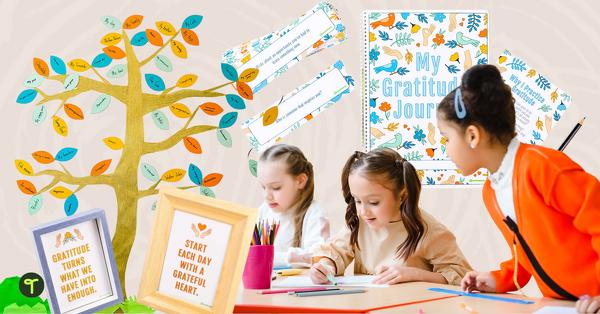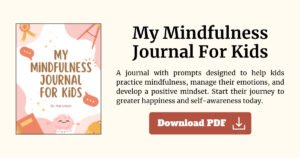10 Gratitude Activities for Kids: How to Teach Children to be Thankful
 How to teach children to be thankful requires helping them to look at their situations from a point of appreciation rather than from a deficit. One of the most significant things parents teach their kids is to say, “thank you” when they receive something, when they’re being helped at, and so forth. It’s a pretty common sight where children even at the age of three will say “thank you” even though they can’t very well pronounce it right, and yes, it’s the cutest thing in the world! But wouldn’t it be fantastic if these lovelies are able to carry this gratefulness habit throughout their lives?
How to teach children to be thankful requires helping them to look at their situations from a point of appreciation rather than from a deficit. One of the most significant things parents teach their kids is to say, “thank you” when they receive something, when they’re being helped at, and so forth. It’s a pretty common sight where children even at the age of three will say “thank you” even though they can’t very well pronounce it right, and yes, it’s the cutest thing in the world! But wouldn’t it be fantastic if these lovelies are able to carry this gratefulness habit throughout their lives?
As more and more Positive Psychology studies have proven that Gratitude is in fact well-linked to Happiness, we appreciate parents and teachers who consistently guide the little creatures to knowing the importance of being grateful. It’s not an easy feat – from going through a barrage of “why” questions, to handling unexpected tantrums, to all kinds of antics just to get away, etc. Plus, they easily get bored. The patience required to instill an attitude for gratitude is definitely something to be applauded for. But again, the long-term benefits of gratitude carried on through adulthood is so well worth it.
Before you continue, you might like to consider our free worksheet on exploring “My Mindfulness Journal For Kids“. Please download this worksheet here.
Gratitude and Happiness Linked
Some of the most noteworthy studies linking gratitude and happiness include Robert A. Emmons and Michael E. McCullough’s three studies wherein they found that the gratitude-outlook groups showed “heightened well-being” thus “a conscious focus on blessings may have emotional and interpersonal benefits”.
In addition, a 2016 two-study published in The Journal of Positive Psychology stated that “grateful remembering as a practice that can bolster present happiness and hope for the future.”
And it does not end there, more and more studies have revealed that Gratitude is also linked to better sleep, improves physical health, reduces aggression and other toxic emotions, improves self-esteem, as well as form better relationships. With all these in mind, families and schools would definitely find instilling gratitude to kids (yes, including teens) truly beneficial.
In a 2019 study by Simone P. Nguyen and Cameron L. Gordon published in the Journal of Happiness Studies, it was revealed that happiness and gratitude are linked even with children by the age of 5. With that in mind, it is worth noting that it’s never too early to get kids to start practicing gratitude. And yes, there are indeed fun activities to help them stray off boredom, all the while learning the significance of being grateful.
Gratitude Activities for Kids
Now, before we start forcing our kiddos to say “thank you” even without them “fully understanding” why they need to do it, an important reminder that kids will likely mirror what they observe. So yes, if you want your children to have this habit stick, best that you practice gratitude as well.
According to a 2016 study, grateful parents raise grateful children. When kids are exposed to gratitude-related activities, usually what they can see from their parents, they are most likely to practice those, too. Now, onward to the activities that teach kids gratitude.
Gratitude Journaling
Now, adults shouldn’t just be the ones making use of cutesy notebooks and pens but children can do, too! Before you tuck them in their beds, have them write one thing they are thankful about in their journals so once they’re in bed to rest, they will feel content. In addition, Journaling has proven to be beneficial as mentioned in many Positive Psychology programs.
Gratitude Walk
Choose an early morning when the sunlight is just right or a late afternoon walk into nature. Take notice of the surroundings around you while you enjoy the beauty of the view, the sounds, the breeze… Note of anything that they are thankful about such as the happy sound of birds chirping, the pretty flowers, the refreshing air, etc. This will help kids realize the beauty of nature and the importance of taking care of them.
 Gratitude Board
Gratitude Board
A chalkboard or a pinboard, this is a fun and a heartfelt way to show appreciation to everyone in your home. Whether it’s a little thank you note to mom who wakes up early in the morning to prepare yummy breakfast daily and prep the kids’ lunchboxes or to dad despite tired coming home from work would still find time to have fun with the kids and even to the annoying older brother who helped with the Math homework. Even the younger kids would feel glad about waking up to a thank you note. Include notes to grandparents and housekeeper/cleaner as well. Who doesn’t enjoy being appreciated?
Gratitude Jar
Have your kids start writing little notes on paper and put them in a jar (or box, if you like). Then you and your kids can choose a schedule to read those notes in the jar – maybe every Friday night or Sunday morning. This way, your kids will be reminded about the little things they are thankful for (and helps them to kickstart their new week).
Gratitude Collage
Another fun way to keep children engaged while learning to be grateful is through collage. Using old magazines, picture books, etc., get them to cut out pictures that would represent the things they are thankful about and then have them glued on paper. You can have this as a monthly activity and by the end of the year, you and your kids can go through their collages they have created for the past 12 months.
Gratitude Photo Album
For older kids or teens who are allowed to handle cameras or have their own phone cameras, you can get them to start a Gratitude Photo Album project. Have them take photos of what they’re thankful for – family, friends, good marks on a test, delicious ice cream, a crush talking to them, etc. Have them save those photos in an album or drive with folder name “Things I’m Grateful For”. Whenever they feel down, you can tell them to check back on this photo album.
Gratitude Sketchbook
For the artistic ones, an unused notebook can be used as a sketchbook where they can draw, paint, sketch anything that made their day (or week) or anything that stood out that made them super happy. Similarly, they can always go back to their Gratitude Sketchbook and reflect.
Gratitude Letter
In this gratitude activity that is backed by Certificate in Positive Psychology courses, we ask kids to write a letter to someone they haven’t had the chance to say “thank you”. It could be someone they know personally or someone they had encountered on a regular or not-so-regular basis, say like a teacher, the doctor or nurse who took care of them, the friendly neighbors, the policemen, etc. If possible, hand deliver the gratitude letter with your kids so they can view firsthand the receiver’s reaction upon getting the letter.
 ABCs of Thanks
ABCs of Thanks
Write each letter from A to Z in separate little papers and fold them. Have your child pick a paper on the pile and let them say out loud what they’re thankful for which corresponds to the letter that they’ve picked. Expect to have some fun and laughter in this creative activity while your kid might mention “I’m thankful for Zebras” or “I’m thankful for the Queen”.
Volunteering Activities/Donate
One way to instill gratitude is to help others. Every once or twice a year (or as many times you can possibly can), have your kids pick out unused items/old toys they can give to less fortunate children. Or have your kids help you prep food to give out to the homeless or orphanages. If the school your children are in has volunteering activities, encourage them to join.
Extra:
Gratitude Meditation for Kids
What an awesome way for the kids how to teach children to be thankful – and a gratitude one at that. Meditation will help kids to become more calm, more focused, have quality sleep, enhanced creativity, and better memory. With gratitude meditation, not only will they feel good afterwards but they also learn to appreciate even the littlest of things.
Ready to help your child cultivate gratitude and appreciation every day? Download our free worksheet to start building a gratitude practice that will bring positivity and happiness into their life.







